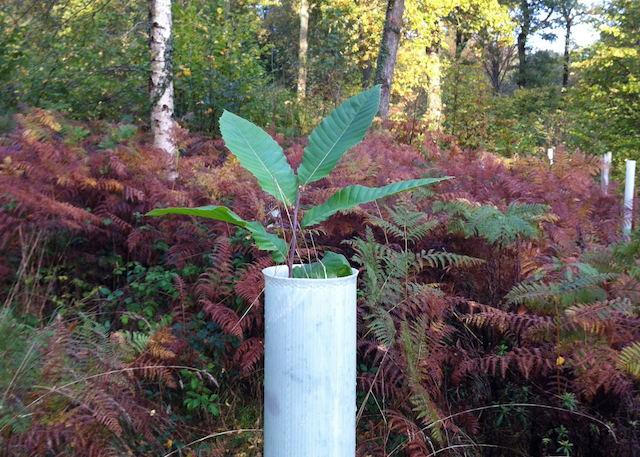The aim of conservation work at Hazel Hill Wood is to help accelerate the diversification of the woodland from commercial forest to a mixed-leaf woodland. Why? Because the more varied the woodland, the greater its likely resilience to a changing climate. Of course, in the normal course of things, the make-up of species in the wood would adapt in response to the changing climate. But these aren’t normal times. Human-induced climate breakdown is causing environmental conditions to change faster than the trees can respond. And so part of our work at the wood is to help accelerate this diversification process.
For many years, the approach was to go into the wood and simply plant a diverse range of trees. Each new tree would get a stake for stability, and a plastic tube around it to protect from the deer. But what we find after decades of this approach is that we have a high failure rate. Walk around the wood and you will find many tree tubes attached to stakes but with no tree inside. What happened? They died, probably because they didn’t the right conditions to survive.
So instead we have been taking a different approach. Rather than planting new trees we look for seedlings that have rooted themselves in the forest floor. They poke up through the leaf litter, sometimes little more than a little sprig with an oak leaf on the end. These are the seedlings that have already self-selected as being a good fit for that location. But they are at risk from the deer. So we put a tree tube around them as protection. It turns out we get a much higher success rate.
Working with complexity
Woodlands are complex ecosystems. Just because we plant something in a location doesn’t mean it is going to grow. And why should it? Why should we get to decide? A much better way to work with the woodland system is to try and figure out what it is trying to do, and to work with that.
This doesn’t mean we don’t have a role to play. Putting a tube around this self-grown seedling is an act of care. Otherwise it would probably get eaten by the deer. Giving this seedling our protection is helping the system go in the direction that it is trying to go.
There are so many complex factors that decide whether a tree will successfully grow in one location or not. Some of these mechanisms we are only beginning to understand, like the way the relationship between mycelium and soil. A tree that is transplanted from site to another has been shown to have a much poorer mycelium interaction than one that has emerged in that soil.
Applications of the seedling analogy
- The seedling analogy helps us work with an #emergent #mindset – looking at what the system is trying to do rather than what we want it to do.
- In management, the seedling analogy helps us think about how managers can support and protect what is emerging from a team of people rather than seeking to impose their will.
- In design – the seedling analogy helps us see what the needs and the opportunities are in the client-stakeholder system, and to focus on these rather than on our own ideas that we are trying to plant on site.
Seeds from afar
The seedling analogy doesn’t mean that we can’t have variation. Seeds are transported into the wood from outside by different vectors. But not all seeds blown in from afar will take root. What does take root needs to be a good fit with the specific needs of that ecology.
And so too for ideas that we may bring in a system. The best determinant of whether an idea is suitable is whether it gets taken up – gets selected by – the system we are working in.
References
Broadbent, O., 2014. The seedling analogy for organisational change. Eiffelover. URL https://eiffelover.com/seedling-analogy-for-organisational-change/ (accessed 11.16.23).
Wohlleben, P., 2017. The Hidden Life of Trees. Williams Collins Books.

